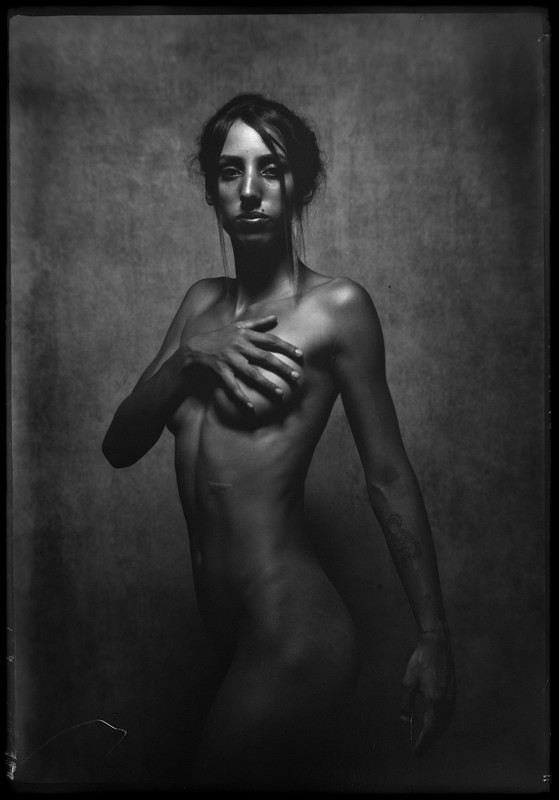When you look at a photograph like the one of Maria, my most popular work on strkng.com, what do you see? Beyond the striking subject and the careful composition, there's a story of process, of deliberate choices, and of a deep engagement with the very essence of image-making. This particular image, like much of my work, is a product of large format analog chemical photography, a practice I've dedicated myself to since 2018. It embodies my commitment to handcrafted tools, sustainable methodologies, and a philosophy that champions the human touch in an increasingly automated world.
Maria – 13x18cm x-ray film reversal processed with Caffenol and Peroxyacetic Solution. © Photographer J Saidler
Crafting My Own Tools: Innovation and Sustainability in Practice
My journey into chemical photography is intrinsically linked to the tools I use, many of which I develop and construct myself. This isn't merely a hobby; it's a fundamental part of my research and artistic expression. I meticulously craft cameras, accessories, and optical systems, often repurposing materials not traditionally associated with photography. This approach, using simple tools and unconventional materials, allows me to imbue each piece of equipment with an innovative and sustainable character. It's a direct challenge to the notion that high-quality photographic instruments must be mass-produced or commercially acquired.
This handcrafted methodology is driven by a philosophical stance: to demonstrate that reliable, beautiful, and effective photographic tools can emerge from unexpected sources. This commitment to accessible and sustainable practices is particularly vital in contexts like Brazil, where access to traditional photographic supplies can be severely limited. My goal is to democratize large format photography, creating methods that yield high-quality images capable of competing with commercial processes, thereby opening up this art form to a wider community.
My Distinctive Process: X-ray Film and Alternative Inversion Techniques
One of the defining characteristics of my photographic research is my exclusive use of X-ray films. This choice is not arbitrary; it's a deliberate exploration of unique visual aesthetics and a push against conventional boundaries. The transformation of these films into positive images is achieved through an alternative inversion process, a technique I've refined to lend a distinctive and captivating effect to my final works. This method not only produces unique visual results but also highlights my ongoing exploration of photographic possibilities that extend beyond established norms, constantly pushing the boundaries of traditional chemical processes.
A Commitment to the Human Element: My Artistry in Portraiture
Beyond the technical innovations, my approach to chemical photography serves as a powerful statement against the increasing influence of automation and artificial intelligence in artistic creation. I believe passionately in the affirmation of human capabilities and the intrinsic value of manual labor. My conviction is that the true essence of creation resides in the artist's unwavering control over each stage of the process, from crafting the tools to developing the final image.
Within my studio, my primary focus is on portraiture. Here, I explore the human form with precision and creativity, with meticulous attention to the careful manipulation of light and the nuanced direction of my models. A key aspect of my studio practice is my commitment to a single exposure per pose. This deliberate constraint introduces an additional layer of complexity and singularity, ensuring that each image is not only technically refined but also profoundly unique, a direct result of my focused artistic intention and skill.
Fostering Collaborative Creation: The CAM-LAB Project
Inspired by this spirit of hands-on creation and my dedication to sharing knowledge, I extend an invitation to those who are inspired to delve into the world of building their own photographic equipment. The CAM-LAB project embodies the principles of accessibility and self-reliance that are fundamental to my photographic research, offering a structured pathway for individuals to engage deeply with the craft by constructing their own tools. This initiative fosters a deeper understanding of the photographic process and empowers participants to unlock new creative possibilities through their own ingenuity and collaborative exploration. Discover the profound satisfaction of creating with your own hands and join me in pushing the boundaries of chemical photography. Learn more and pre-register at: https://lab-cam.jsaidlerfotografia.com.br










